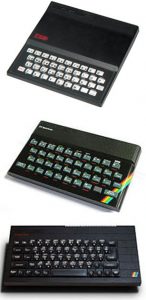ZX microcomputer family
The ZX models were manufactured and marketed by Sinclair Research, a company founded by Sir Clive Sinclair. The ZX Spectrum was the market leader in Europe and the USA for nearly 10 years.
Below we will describe the ZX80, ZX81 (top), ZX Spectrum (middle) and ZX Spectrum+ (bottom) in more detail.
Use
Games
Learning computer programming
Widespread worldwide, still in use in the 2010s
ZX81 and ZX Spectrum: Computer Science History Exhibition
Structure
Central unit
Byte-organized home computers; 8 bpB
Their logical structure is identical and – with the exception of the control microprocessor – they are built from TTL logic circuits.
- controller: Zilog Z80 microprocessor, clock speed: 2.5 MHz
- main store:
- RAM:
- Z80 and ZX81: 1 KB
- SP: 16-48 KB
- SP+: 128 KB
- ROM:
- ZX80: 4KB
- ZX81: 8KB
- SP: 16 KB
- Sp+: 32 KB
- RAM:
- calculator: ALU built into the microprocessor
Periphery
- backup storage: tape cassette ( microdrive )
- external devices:
- composite video signal for CRT display or TV
- ZX80 and ZX81: monochrome
- SP and SP+: color
- foil-contact (capacitive) rubber pad keyboard
- printer: ZX printer
- ZX80 and ZX81: "edge-connector" motherboards for floppy disk and printer connections
- sound output: 1-channel beeper (5 octaves), built-in speaker
- SP+ only: 3-channel sound generator (AY-3-612)
- SP and SP+ interfaces:
- standard (RS-232) serial port
- Interface I : two (self-developed) network ports (for connecting up to 8 tape cartridges or up to 64 machines, via 100 kbaud ZXNet)
- Interface II : 8 KB ROM and joystick connection
- SP+ only: MIDI connector
- composite video signal for CRT display or TV
Operation
A single-address instruction set, the 16-bit address section allowed addressing of 64 KB of logical address space; larger memory was handled by the processor using paging.
ZX80 and ZX81: programs stored in ROM had to be loaded into RAM, commands could be given from function keys.
Screen resolution:
- in text mode: 24 lines, 32 chpl
- For SP and SP+, 2 colors per character
- in graphics mode: 256*192 pixels
- ZX80 and ZX81: "slow mode" only, for displaying still images
- ZX81: “fast mode”: video signal off
- SP and SP+: 15 colors per pixel (8 primary colors, light and dark shades)
In fast mode, the main memory could also be used as a video memory, and monochrome pseudo-graphic characters could be "drawn" with a resolution of 64 chpl in 48 lines; in this case, 384 B remained for programming.
Program set
- Operating system: Sinclair BASIC
- compiler: BASIC
About 20,000 game programs were available on cassette tapes.
Historical curiosities
Nothing proves the popularity of the ZX Spectrum better than the fact that countless clones were made from Brazil, Czechoslovakia, Romania, Bulgaria, and the Soviet Union, and were in large numbers until the mid-1990s.
Programs were still being developed for the machine in the 2010s, and fan clubs around the world continue its fame; the Hungarian club is called Speccyalists, as the machine was also nicknamed Speccy.
The ZX Spectrum 128K was released in 1985, first launched in Spain, Sinclair's second largest market. Although it looked very similar to the Spectrum+ - apart from a large and very hot heatsink on the right side - the most important differences were hidden inside the box:
- 128 KB RAM
- new, three-channel sound chip, very similar to the Atari ST's
- new BASIC interpreter
- new connectors – including finally a monitor output.
In Spain, an external numeric keypad was also included with the machine.
Sinclair Research's computer business and brand name were acquired by Amstrad in 1986, and improved versions of the machine (Spectrum+2, Spectrum+3) were released there; however, production of the Spectrum 128K was discontinued and it was removed from the shelves after only six months.
“Sir Clive introduced a portable computer (Z88) in 1987, and since then he has surprised the world with numerous new inventions – an electric wheelchair motor, a headset, a folding bicycle – when he is not shining at poker tournaments.” ( In Praise of the Future’s Past, pp. 156-161.)
Resources
Overview of the Spectrum family: Sinclair Spectrum
More detailed description: ZX Spectrum (English)
Detailed history: Spektrum turns 30
Tribute to the ZX-81 on its 40th birthday
Created: 2016.05.21. 23:24
Last modified: 2021.03.17. 19:52

